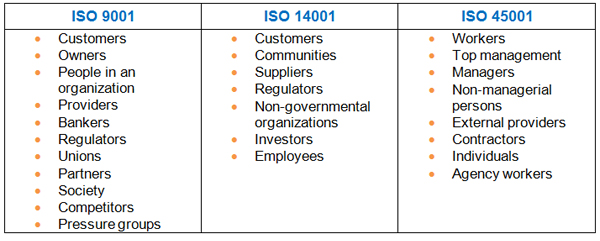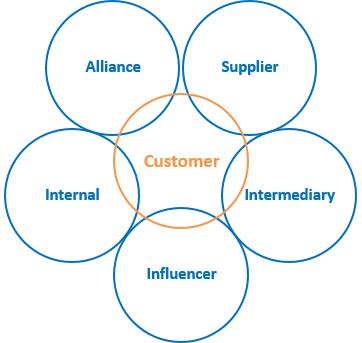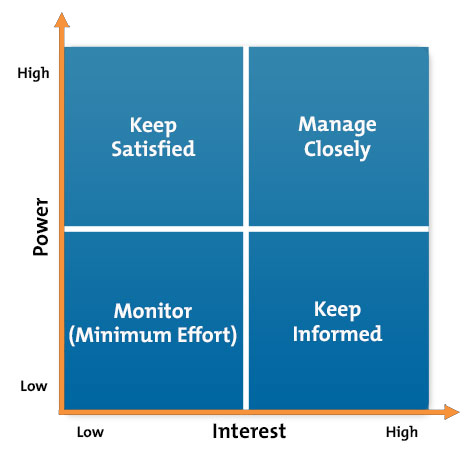Interested Parties: How to define and manage them
The need for organizations to understand the needs and expectations of interested parties is a mandatory requirement of the management systems standards ISO 9001, ISO 14001 and ISO 45001.
But who exactly are Interested Parties and how do you manage them?
Read on for practical steps to identify, understand and prioritize your interested parties.
Understanding the needs and expectations of interested parties
The importance of stakeholder management to the success of an organization cannot be underestimated – without exaggeration, it is far more than customer focus; it is about actively understanding and managing the positive, negative and changing influences from a range of stakeholders.
Stakeholders are referred to synonymously as Interested Parties by ISO management systems standards – ISO 9000 states their importance clearly:
“Organizations attract, capture and retain the support of the relevant interested parties they depend upon for their success.”
Because interested parties are so important, they are considered an integral part of the context of the organization (see our article on How to Define Context); they should be well understood before defining the scope of the management system – in reality it is more of an iterative process which adapts to changing needs.

The requirement to understand the needs and expectations of interested parties is expressed almost identically in each standard as:
The organization shall determine:
a) the interested parties that are relevant to the management system;
b) the requirements [needs and expectations] of these interested parties that are relevant to the management system
So the standards expect you to you decide who is relevant and then what they need – but how? And where do you begin?
who are interested parties?
Firstly, it is essential to understand the definition of Interested Parties – ISO 14001 and ISO 45001 both define interest party as a:
“person or organization that can affect, be affected by, or perceive itself to be affected by a decision or activity”
This could be interpreted very widely, so each standard adds guidance notes:
-
ISO 45001 notes that “This International Standard sets out requirements with respect to workers who are also interested parties”;
-
ISO 14001 notes that “To ‘perceive itself to be affected” means the perception has been made known to the organization” – this could include feedback or comments via the organizations social media channels;
-
ISO 9000 also explains the concept of Interested Party in the context of quality management:
-
“The concept of interested parties extends beyond a focus solely on the customer. It is important to consider all relevant interested parties”.
-
“The relevant interested parties are those that provide significant risk to organizational sustainability if their needs and expectations are not met”.
-
This is a good starting point, but it’s a bit like reading the dictionary before writing a letter – theoretically sound, but not very practical.
Let’s move to specific examples and methods...
Examples of Interested Parties
Each management systems standard goes on to provide generic examples of Interested Parties – these are presented in the table below.

You should be aware that some examples (e.g. workers) have their own definition, which then includes additional examples. It is important to read the definitions in each standard.
It should also be noted that these examples are not:
1. mutually exclusive and can cross over between management systems depending on relevance;
2. exhaustive and should be considered as a starting point only.
Classifying Interested Parties AND THEIR RELATIONSHIPS
Simply listing suppliers, customers, communities etc. is not enough to meet the requirements of the standard i.e. understanding the needs and expectations of relevant interested parties.
Make the information more meaningful by grouping interested parties based on their relationship with the organization. This is advised in ISO 14004 – EMS Guidelines for Implementation, which provides examples of interested parties based on their relationship with the organization, by their:
- Responsibility – investors, etc.
- Influence – pressure groups, etc.
- Proximity – neighbours, etc.
- Dependency – employees, etc.
- Representation – trade unions, etc.
- Authority – regulators, etc.
Some categories may contain sub-categories, which require a different management approach. For example customers may include key accounts which have different needs and expectations to transactional customers.
Another method of categorizing interested parties is the 6 Market Model referred to in our article on How To Define Context:

Relevance, needs and expectations
Now you know who your interest parties are, it is time to identify their needs and expectations which are relevant to your management system. The operative word here is relevant.
Depending on the size and complexity of your organization, it is very likely that you or your colleagues will have a good feel for the interested parties you have regular contact with. However, it is worth formalizing this knowledge and, where needed, confirming assumptions and closing knowledge gaps with research.
The scale of research again depends on the size and complexity of your organization. For example:
-
A two-person gardening firm may be able to complete research within a few phone calls to clients, suppliers, local council etc.
-
A multi-national pharmaceutical company may require a range of research methods (quantitative and qualitative, primary and secondary).
Power and Interest (Significance and relevance)
A useful tool for helping you decide how to manage a particular interested party is the Power/Interest Matrix developed by Johnson and Scholes.
This simple tool relates two important relationship variables:
-
How much interest do they have in your decisions and activities? This could be interpreted as the strength of their relevance.
-
How much power or influence do they have over your decisions and activities? This could be interpreted as their significance or risk.
Plotting interested parties helps to prioritize the effort required to meet their needs and expectations:

process for mapping interested parties
-
Identify relevant interested parties. Use the examples from the ISO management systems standards, 6 Market Model and other methods to compile a categorized list of your interested parties.
Tip: create a table or spreadsheet with a column for Interested Parties, add columns for Needs and Expectations, Power/Interest and Objectives. -
Determine their needs and expectations. Use different research methods as necessary to confirm your knowledge of each group or significant stakeholder.
Tip: summarize the findings and add them to the relevant column in your table of Interested Parties. -
Rank them in terms of power and interest: Consider their strength of interest and level of influence over your decisions and actions. Plot them in the Power/Interest Matrix to determine their rank.
Tip: add the rank to the relevant column in your table of Interested Parties. -
Set objectives and priorities. Define what results are necessary to deliver to those relevant interested parties to reduce the risk that their needs and expectations are not met.
Tip: set SMART objectives wherever possible and document them in the table of Interested Parties.
You should end up with something like this example – but create a framework that suits your own needs:

Summary
Taking the time to understand the needs and expectations of your interested parties is very worthwhile and essential to:
- defining the scope of your management system
- ensuring customer satisfaction
- meeting compliance obligations
- continual improvement of the organization and its management system
- meeting the requirements of ISO 9001, ISO 14001 and ISO 45001
By using the methods described in this article, you should be able to develop your own process or framework for identifying, understanding monitoring and reviewing interested parties in terms of:
-
Level of interest (Relevance)
-
Level of influence (Significance)
You should be able to demonstrate a process that connects your interested parties with the scope of your management system and informs the development of policy and objectives.

What is your experience of managing interested parties?
If you have experience of using these or other methods, please share your knowledge to help your peers improve their management of interested parties.
Share via the blog comments below or on Twitter and LinkedIn using #ISOinnovate.
